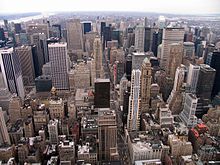
Back جغرافيا حضرية Arabic Урбаністыка Byelorussian Урбаністыка BE-X-OLD Градска география Bulgarian शहरी भूगोल Bihari নগর ভূগোল Bengali/Bangla Geografia urbana Catalan جوگرافیای شاری CKB Geografie sídel Czech Stadtgeographie German

Urban geography is the subdiscipline of geography that derives from a study of cities and urban processes. Urban geographers and urbanists[1] examine various aspects of urban life and the built environment. Scholars, activists, and the public have participated in, studied, and critiqued flows of economic and natural resources, human and non-human bodies, patterns of development and infrastructure, political and institutional activities, governance, decay and renewal, and notions of socio-spatial inclusions, exclusions, and everyday life. Urban geography includes different other fields in geography such as the physical, social, and economic aspects of urban geography. The physical geography of urban environments is essential to understand why a town is placed in a specific area, and how the conditions in the environment play an important role with regards to whether or not the city successfully develops. Social geography examines societal and cultural values, diversity, and other conditions that relate to people in the cities. Economic geography is important to examine the economic and job flow within the urban population. These various aspects involved in studying urban geography are necessary to better understand the layout and planning involved in the development of urban environments worldwide.
- ^ Soja, Edward W. "Taking space personally." In The Spatial Turn, pp. 27-51. Routledge, 2008.
© MMXXIII Rich X Search. We shall prevail. All rights reserved. Rich X Search